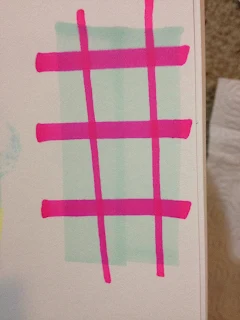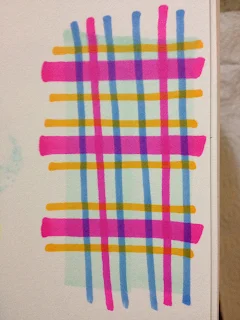Creating Plaid Patterns with Copics and Watercolors
Recently I was asked over Twitter how to go about making a plaid pattern. The asker didn't specify the media, so I did two varations- Copic marker and watercolors. There isn't much of a difference between the two, and they could be interchangeable, but watercolor takes longer to dry, and color layering with alcohol based ink won't have the same effect as glazing will with watercolor.
Plaid isn't a hard pattern to replicate, it just takes a little patience and maybe a little reference. There's a variety of ways you can go about doing it- marker on marker, paint on marker, gouache on marker, color pencil on marker, watercolor on watercolor, gouache on watercolor, pencil color on watercolor. For this demo, I'm focusing on marker on marker, watercolor on watercolor, and gouache on watercolor.
When recreating a plaid pattern, it helps to have a little reference. For my examples, I didn't really care about color, but if you're recreating a tartan, its important to know exactly what the colors are, as they have particular significance. A little Google searching brought up several nice examples of plaid.
There are some major characteristics that plaids have that you should note when recreating them:
Overlapping colors
Varied line widths
Opacity and transparency
Regular spacing
Once you have a ground down, it's mostly just a matter of laying down lines. I try to do all of a particular type in a particular color at one time.
Plaids are a repeated pattern, so you want to keep that in mind when you're laying down lines.
Very wide stripes can be applied using Copic Wide markers.
Working with Copic Wide markers requires care, as they have a tendency to skip.
When using watercolors to create a plaid, make sure you give each layer enough time to dry before applying subsequent layers.
Plaid isn't a hard pattern to replicate, it just takes a little patience and maybe a little reference. There's a variety of ways you can go about doing it- marker on marker, paint on marker, gouache on marker, color pencil on marker, watercolor on watercolor, gouache on watercolor, pencil color on watercolor. For this demo, I'm focusing on marker on marker, watercolor on watercolor, and gouache on watercolor.
Examples
| Source |
| Source |
 |
| Source |
 |
| Source |
There are some major characteristics that plaids have that you should note when recreating them:
Overlapping colors
Varied line widths
Opacity and transparency
Regular spacing
Copic Version 1
When recreating a plaid with Copic markers, I use Copic Wide markers to lay down a color ground first. When creating a plaid, you should consider utilizing the chisel nib end rather than the brush end, so that your lineweight doesn't waver mid line.Once you have a ground down, it's mostly just a matter of laying down lines. I try to do all of a particular type in a particular color at one time.
Plaids are a repeated pattern, so you want to keep that in mind when you're laying down lines.
Copic Version 2
The ground color of a plaid can be multicolored, it doesn't just need to be a single hue. To achieve this, I apply alternating colors using Copic Wide markers.Very wide stripes can be applied using Copic Wide markers.
Copic Version 3
A plaid can even be as simple as a multicolor checkerboard, with wide stripes layered on top of one another, creating an optical 5 hues instead of the three applied.Working with Copic Wide markers requires care, as they have a tendency to skip.
Watercolor Version 1
When using watercolors to create a plaid, make sure you give each layer enough time to dry before applying subsequent layers.



























So as a fiber artist, I've done some weaving and thought you might find some information on how plaid fabric is made which affects the appearance of the cloth that you are trying to capture in your art. Plaids are really just a series of stripes and the same series of stripes rotated to be perpendicular to the first. In most plaids the stripes are symmetrical because the stripe pattern is strung and woven on the loom foreword and backward (if your stripe pattern is green blue green purple the loom is strung green blue green purple purple green blue green).
ReplyDeleteThe diagonal breaks you see in stripes of plaids are a result of how the fabric is woven. Plaids are traditionally woven in a basic twill weave which means a thread passes over 2 threads and then under 2 threads. The next thread does the same but is staggered one thread over which creates a diagonal effect. This diagonal pattern runs in the same direction for an entire piece of cloth no matter whether the stripe is a horizontal one or a vertical one.
You can integrate these facts into your own art by remembering to draw the horizontal and vertical strips of a plaid identically in the pattern of stripe widths and colors and having the diagonal grain of your plaids go in the same direction for the whole piece of cloth.